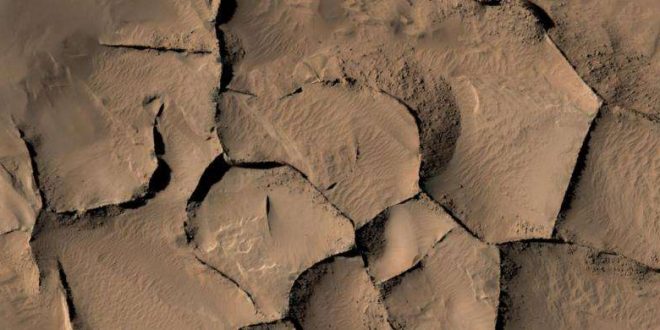Ridges of various sizes have been located in many regions of the Martian surface, and scientists surmise that they originated in a variety of processes and events.
Laura Kerber of NASA’s Jet Propulsion Laboratory conducted a detailed search for these ridges after discovering a network of polygon-shaped features in Medusae Fossae, a location close to Mars’ equator.
The ridges of Medusae Fossae, which Kerber found in images captured by NASA’s Mars Reconnaissance Orbiter (MRO), are tall, stretching as high as 16 feet. Thin and shaped like blades, they intersect one another, dominating the region.
“Finding these ridges in the Medusae Fossae region set me on a quest to find all the types of polygonal ridges on Mars,” said Laura Kerber.
The pattern is sometimes called boxwork ridges. Raised lines intersect as the outlines of multiple adjoining rectangles, pentagons, triangles or other polygons. Despite the similarity in shape, these networks differ in origin and vary in scale from inches to miles.
Small and Large Examples
Mars rover missions have found small versions they have been able to inspect up close. Some of these polygonal ridges, such as at “Garden City” seen by Curiosity, are veins deposited by mineral-laden groundwater moving through underground fissures, long before erosion exposed the veins. Curiosity recently also imaged small boxwork ridges that likely originated as mud cracks.
At the other end of the size scale, ridges outline several rectangles each more than a mile (more than 2 kilometers) wide at a location called “Inca City” near Mars’ south pole. These may have resulted from impact-related faults underground, with fractures filled by rising lava that hardened and was later exposed by erosion.
“Polygonal ridges can be formed in several different ways, and some of them are really key to understanding the history of early Mars,” Kerber said. “Many of these ridges are mineral veins, and mineral veins tell us that water was circulating underground.”
Polygonal ridges in the Nilosyrtis Mensae region of northern Mars may hold clues about ancient wet, possibly warm environments. Examples of them found so far tend to be in the same areas as water-related clues such as minerals that form in hot springs, clay-mineral layers and channels carved by ancient streams. A larger sample is needed to test this hypothesis.
Volunteers Sought
Kerber is seeking help from the public through a citizen-science project using images of Mars from the Context Camera (CTX) on Mars Reconnaissance Orbiter.
“We’re asking for volunteers to search for more polygonal ridges,” she said. Finding as-yet-unidentified polygonal ridges in CTX images could improve understanding about their relationship to other features and also will help guide future observations with the High Resolution Imaging Science Experiment (HiRISE) camera to reveal details of the ridge networks.
This citizen-science program, called Planet Four: Ridges, began Jan. 17 on a platform released by the Zooniverse, which hosts dozens of projects that enlist people worldwide to contribute to discoveries in fields ranging from astronomy to zoology.
Other Zooniverse Mars projects using data from CTX and HiRISE have drawn participation from more than 150,000 volunteers.
On Earth, too, polygonal ridges have diverse origins. Examples include grand walls of lava that hardened underground then were exposed by erosion, and small ridge networks inside limestone caves, where erosion can be chemical as well as physical.
With CTX, HiRISE and four other instruments, the Mars Reconnaissance Orbiter has been investigating Mars since 2006.
Agencies/Canadajournal
 Canada Journal – News of the World Articles and videos to bring you the biggest Canadian news stories from across the country every day
Canada Journal – News of the World Articles and videos to bring you the biggest Canadian news stories from across the country every day



